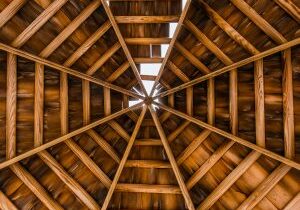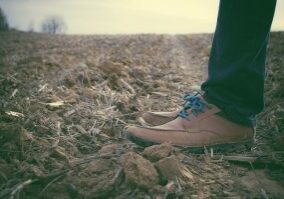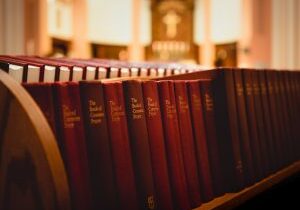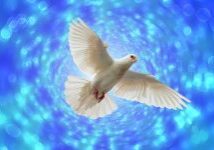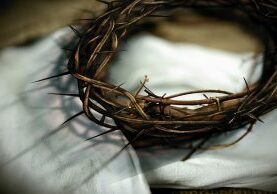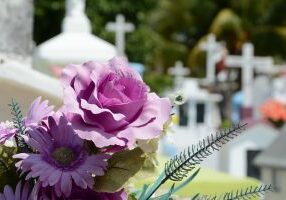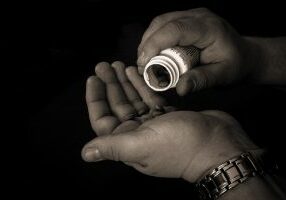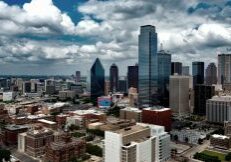Crafting Community Through Old School Makerspace
AMIA Communications
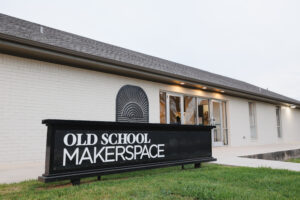 Listen in as we talk with Robert+ Balfour, Associate Priest of Grace Northridge Anglican Church and Director of Old School Makerspace, a creative coworking space focused on building community and making a positive impact in San Antonio and beyond.
Listen in as we talk with Robert+ Balfour, Associate Priest of Grace Northridge Anglican Church and Director of Old School Makerspace, a creative coworking space focused on building community and making a positive impact in San Antonio and beyond.
How did Old School Makerspace get started?
Old School Makerspace is the product of collaboration of several individuals from the San Antonio area. When I first was discerning ordination and trying to get connected with churches in the mission, I shared with a couple of individuals my desire to use woodworking, something that had been a side business and a passion of mine for many years, as a way of building community. I had done some work with a mentoring program that had worked with youth in my shop in California while in seminary and had early positive experience with that; and I wanted to see how that could be an avenue for discipleship and evangelism. Both individuals I spoke to within the mission mentioned this church in San Antonio, Grace Northridge, that generally was open to missional sorts of things, to out-of-the-box ministries.
My wife and I discerned a call to come to Grace Northridge Anglican Church and came with the intention of starting a new ministry as part of a three-year mission residency program that I was participating in. We met +Matt Kessler, who was pastor at the time, and he showed me around this building on the property: a 4,000-square-foot building that was sitting vacant and had previously been used as a preschool. It was an old building with drop ceilings and carpet squares and blue walls, and not exactly my dream shop at first, but it had the raw materials to create a space to gather people. So, we started considering, “How could we use this space? How could we remodel it?”
There was an existing model called a makerspace, which has popped up in various places around the country. Essentially, it’s a place where people share space, tools, ideas and common knowledge around various areas of making, and then they build community around that. So that wasn’t our idea originally. In many ways, I think in response to the DIY movement, it represented a desire to go deeper in those things beyond what one could just do in their garage.
So, we had a model, we had a building and then I began to build relationships with other people with similar passions. In the process, I got connected with a number of fine artists. That really wasn’t my area of focus going into it, but as we discerned and talked and prayed, what we came up with was this notion of a makerspace that would serve both fine artists as well as those interested in crafts such as woodworking and metalworking.
What we realized is that painters and ceramicists and others may have similar desire for community and a chance to build connections around that. So, we spent some time dreaming and creating a vision. Essentially, we wanted to see, “Is this something that actually is feasible and are we going to meet a felt need of our community? Is it just our idea or is there proof of concept?” So, in February of 2019, we began having monthly meetups in areas of woodworking, painting and drawing, and then also some classes in ceramics that we did from people’s home studios and wood shops.
In that first year, we had about a hundred people participate in our events—without a central building or a facility that would draw people and without a website. So, we felt that was a pretty good proof of concept.
We began construction on the building in December of 2019, working with a contractor to take care of the drywall and the mechanical, electrical and plumbing work. We had to redo all of that as well as change some of the footprint of the building.
Then in March 2020, everything changed. So, we stopped meeting in people’s home studios for several months and switched up to working on the building. We had several work days throughout that six-month period where we as a community did the painting, put down baseboards, built cabinetry and tables and refinished floors. We were able to engage the community in a time when it was hard to meet otherwise, spread out throughout that 4,000-square-foot building. It was a difficult time, but a unique time in our development to build community and as a community realize the vision of the building.
Then in April 2021, we began hosting events in the space: meetups, classes and open shops. The hope was that all of them would give people a chance to get to know one another. Since then, we’ve had about 650 people use the space. Of those people, 82% are not from our church; they’re members of the community that connected with us in other ways. Some of them are connected to other churches, but many of them are not connected to any church.
Making art is the central point of how we’re gathering community. I think we probably have more diverse community theologically than we would if we were running something along the lines of sports or fitness. When we have a group of people here, if you just go out in the parking lot and you look at the bumper stickers, you realize that there’s a diversity of beliefs among those who participate in our events. I’d say 30% or 40% of those who come probably hold to some different views of theology than our church does. So that’s encouraging to me. I want to be in conversation with people from a variety of backgrounds and walks of life. The makerspace has given us a chance to do that, maybe because it is geared toward arts and making. I think there’s a higher concentration of people who either have had negative experiences with the church or who have a pretty different worldview within the artistic community.
Our purpose in developing the space really was to get to know our neighbors, to serve and meet a real need that they have, and then to provide opportunities for those who are interested in exploring the intersection in faith and making. We do that in a number of ways through events as well as hosting Alpha classes and things like that in the space.
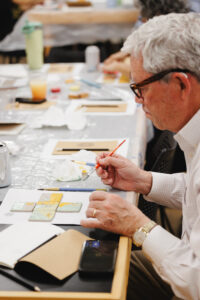
What does it look like for members of Grace Northridge to be involved in Old School Makerspace?
That’s something we’re still trying to figure out. For the people in our church who are inclined toward making, toward the arts, it’s been a place for them to engage their creativity and to do so in a
way that’s connected to their faith. We’ve been able to offer a more robust discipleship to those who are inclined toward these things.
There’s also a number of people who don’t have a regular practice of making who are interested in learning new things. They’ve had more casual engagement with the space. Our hope is that more and more people would take it as an opportunity to invite friends and neighbors to work side by side with them and that it would have a positive effect of helping them naturally have gospel conversations. In these next couple of years of operation, we really want to home in on how we help our people use this space missionally with the purpose of sharing both their lives and the gospel with the participants.
Would you talk to us a little more about Old School Makerspace’s focus on community and making a positive impact in your city and beyond? What does that look like and what do you envision?
What we realized is that creativity can be really therapeutic for people. It can be a really good outlet, particularly during stressful times. The mental health challenges in our city and beyond in our nation are pretty significant. And so, as I think about our community impact, I often think about how we can leverage our facilities for the benefit of others in the community, especially for those who are dealing with difficult situations. We’re still trying to develop that.
Today we have a group of CPS (Child Protective Services) caseworkers doing their quarterly eight-hour meeting in our space. But in the middle of that, we have a two-hour ceramics class where one of our ceramics instructors provides this hands-on team-building experience where they’re able to make art together. They’ve said it’s one of the few places where they have actually been able to laugh together. Most of their work and most of their days are really heavy. They’re dealing with kids that are being neglected or abused. And so, how can we use our facility and use the people in our space who have these gifts and this passion for teaching the craft? How can we use it to help people deal with challenging everyday realities?
There’s a group that works with victims of sex trafficking that will have a retreat here soon. We’re also working with a group foster home to do monthly meetups with young people in their community to help them learn skills and provide an outlet for some of the challenges that they face.
We’ve also made things like tables for an organization that provides food for kids so they could pack more effectively. So, we’ve done some actual physical building of things that could be helpful. We’re still trying to figure out what it looks like to do that to support our community, but it’s something we’re pressing into.
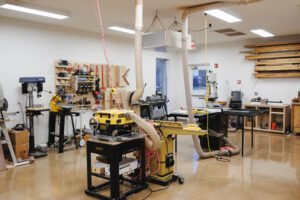 As you think about what you’re pressing into, what are you most excited about? Where would you love to see Old School Makerspace in a few years?
As you think about what you’re pressing into, what are you most excited about? Where would you love to see Old School Makerspace in a few years?
When we first started doing this, I think each member of the team had a different focus and hope. My main focus and hope have been the evangelistic piece: How do we connect with our neighbors who don’t know the Lord and build relationships with them? But recently it has become more clear that we really could have a positive impact on the discipleship of believers who either are inclined toward creativity or who might benefit from incorporating creative practices as spiritual disciplines. And so, that’s a piece that we’re really trying to make more robust. We have events called “Faith in the Maker” twice a year, one in the spring, one in the fall, and they’re designed to help people explore that intersection.
We’ve mostly brought in people who are believers and are creative but who maybe have not felt like the church has taken their vocation or their gifts seriously, or has taken them only opportunistically. Getting to a place where we are helping advance the conversation around art and faith is something that I’m excited about and hopeful for.
I was concerned when we first started this that it would become a sort of Christian enclave, that we would just have a bunch of people from our church and we wouldn’t have the outreach piece. But in fact, we’ve had a lot more outreach than I anticipated initially. And so, I’m realizing that we’ve gathered a lot of folks, but it’s not clear to me that we’re doing all we can to pastor them and invite them to explore faith. I’m excited to continue moving forward in that direction as well.
What would you say to someone who’s interested in using the arts, using creativity and craft to build community and to engage people on a spiritual level?
I would encourage them to take stock of who God has put in their community and take inventory of what their broader community is like. It is easy for us to start with this vision without really taking adequate stock of whether God has equipped us to realize it. Try to understand your physical resources, your community resources. What kinds of creative people do you already have in your community that could help move the needle on these sorts of things? So, I think the first step is to take a clear and honest assessment of your strengths and the needs of the community.
And from there, spend time discerning through prayer and Scripture, really trying to get a sense of “What might God be calling us to do?” I think a lot of people are inclined toward finding a model and trying to make that model work, but I would opt for a more organic approach, one that holds open the possibility of a number of different ways in which the vision might be realized. I’ve seen it done in a lot of places in a lot of different ways.
Rather than start with a preconceived idea of what the final product is, take the time to discern who God has brought who can be part of that conversation. What we’re doing has been shaped by a dozen people who all have a particular calling and have a particular sensitivity toward some aspect or another of what we do. And we’ve had to continue to adapt and to discern what things look like in each season.
How could readers pray for you in this season and as you look to move ahead?
We’re essentially three years into operations, and we want to look back and say, “Here’s what we set out to do. Here are the things we’re doing. How well do these things accomplish the vision that we have had? Has that vision adapted or changed in any way?” In many ways we’re reentering that discernment phase. And so, prayer for clarity on the next phase of this life of the ministry that we’re doing would be really helpful.
As well, I’ve been thinking a lot about Jesus’ statement, “the harvest is plentiful, but the workers are few,” and I feel that that’s very much the situation for our makerspace. I pray for more workers, more people who have a passion for this who can come alongside and support the ministry. I just don’t think we can program the ministry. The programs are good, and we’re going to need them; but it’s going to be relationships and investment from people that will ultimately move the needle for those who are seeking to know the Lord, but maybe need direction. So, I’d appreciate prayers for discernment overall for the organization as well as for more people who have a shared vision to be a part of that, to be more workers for the harvest field.
Is there anything else that you’d like to share about Old School Makerspace and the role of creativity?
Old School Makerspace is underneath the umbrella of Grace Northridge Anglican Church. It’s been really neat to see how the two can encourage and edify one another. Over the last couple of years, we have brought creative expression more and more into our worship, whether it’s an art installment that we’ve done or the use of poetry on Easter Sunday. What has been encouraging to me is that these things have naturally flowed, and forming community around creative expression has helped to bring more of that within the life of our church in general. That wasn’t a planned or programmed thing, but a really helpful byproduct of where we’ve been.
As Malcolm+ Guite shared at Live the Mission, the role and importance of imagination in our faith has been neglected very much in the Western Church. We can’t fix everything about that, but we can press into beauty and truth, recognizing that it’s far more than ornament, it’s far more than decorative. I think that’s essential in how we articulate the gospel in this new era that we find ourselves in.
I believe firmly that the arts are an integral part of helping people grow in their faith as well as communicating the truths of the gospel to a world that’s hungry for beauty. My hope for others and for us is that we would faithfully follow God as he leads us to move in that space.

Category: Discipleship, Evangelism and Outreach, Spiritual Growth
Tags: art, creativity, Old School Makerspace


